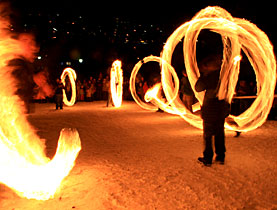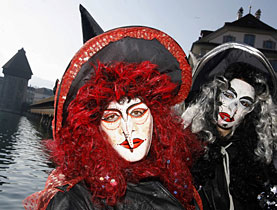A fool and his oranges are easily parted

There will be plenty of fools, plenty of noise and plenty of oranges in the streets of Swiss towns and villages in the last week of February.
This is the time of fasnacht, or carnival, the period just before Lent, the 40-day fast in the Christian calendar that precedes Easter.
The customs of the villages around Schwyz, the capital of one of Switzerland’s central cantons on the shores of Lake Lucerne, are a little different from the cheerfully noisy and sometimes satirical parades of the big cities like Basel, Zurich and Lucerne.
All are part of a conscious revival of tradition in the 19th and 20th centuries and all have a subversive edge. But the Schwyz area is distinguished by its cast of traditional figures, the Nüssler, who dance in the streets on fasnacht days.
Stefan Marty, the “narreschriiber”, or “fools’ scribe” – more prosaically, the secretary – of the carnival company in the area of Steinen, told swissinfo that one of the main attractions of joining in the festivities is the chance to go around unrecognised.
“We can say certain things to people which we wouldn’t say otherwise,” he explained.
But it’s always done in a humorous way; the important thing about fasnacht is that it is fun. Even if people think they recognise you, it doesn’t really matter – and they can never be quite sure.
“We enjoy the privilege of court fools,” Marty claimed. “But we have to know the boundaries that we mustn’t overstep.”
Exuberance
Another attraction for the participants is the conviviality which surrounds the carnival event.
“We have so many problems and responsibilities today, so we relish the chance to switch off from normal life for three days and spend a few cheerful hours with friends. But alcohol is always a factor you have to be careful of…” Marty explained.
It has been ever thus. Although we know few details of fasnacht festivities before the 19th century, we do know that the authorities often tried to ban them both because of their unbridled exuberance and because of their subversive nature.
Today they are very much part of the landscape, and attract enthusiastic crowds. Uninitiated visitors may be surprised to notice that many of the children are carrying large bags but the reason is soon evident: large quantities of oranges, sweets, sausages and bread are handed out to the onlookers.
The main expense for participants is the dressing up. The costumes – and they must be correct in every detail – cost up to SFr1,000 ($860). If you don’t own one, you can hire it. But then you can reckon on spending a good SFr100 francs for one day. Not surprisingly, some people make their own, and hand them down from one family member to the next.
The masks are a specialist job. Wooden ones are expensive, but last a lifetime. The much cheaper wax and cardboard ones will last at most three days if treated carefully.
Characters
There are six core Nüssler characters, which betray a range of influences from both south and north. This area lies on the road to Italy over the Gotthard, well travelled by both traders and troops.
The chief figure is the Blätz. He takes his name from the diamond-shaped patches of cloth – Blätz in Swiss German – sewn onto his costume. He is clearly derived from the Harlequin of the Italian Commedia dell’Arte. In Brunnen the Italian influence is even clearer: it is a figure named “Harlegingg” which is burnt at the end of fasnacht.
But the actual custom of burning an effigy to mark the end of winter is observed all over the country. Like many other traditional Swiss figures the Blätz wears bells, which jingle when he dances. And he carries a broom made of twigs – a symbol of fertility also carried by “wild men” far beyond central Switzerland and far outside carnival time.
Another figure with an Italian background is the Bajazzo. In some places this is a boy, in others a girl. It takes its name from the Italian clown, Pagliaccio, and wears a baggy dress and pointed hat. The Domino also comes from Italy; his most striking characteristic is his pointed hood and broad collar.
Also exotic is the dark-faced gypsy, who carries a tambourine and keeps time with the drummers.
And finally, two figures from closer to home. One is the “Hudi”, an old woman in a hooped dress and brightly coloured hat, who carries an open parasol and has her oranges in a basket over her arm. Although in local Swiss German “Hudi” is a pejorative term, this figure is seen as lovable and friendly.
The other is the “Alte Herr”, or “Old Gentleman”, dressed like an 18th century aristocrat, with curled wig and tricorne hat, who hobbles along leaning on his gnarled walking stick – until it comes to dancing, where he jumps with the best of them.
Dance
Along with the costumes, the most distinctive thing about these characters is the Nüssler dance, a step dance performed to the beat of drums. It is said by some to derive from the ceremonies in which mediaeval troops used to be psyched up before going into battle. Not for nothing are the carnival groups known as “Rotten”, a word originally used for a small military unit.
“The dance is something you learn as a child. It’s like riding a bike: once you know it you don’t forget it,” Marty said.
Marty has no fear that the Nüssler custom will die out. “People are fascinated by it; it’s something that unites them,” he said.
“We love keeping an old custom alive.”
swissinfo, Julia Slater
The Nüssler figures are found in several villages around Schwyz, the capital of the canton of the same name.
They originally handed out nuts – “Nüsse” in German, hence the name – but now give oranges, sweets, bread and sausages.
There are six core characters, but each village has slight variations.
The colours and precise rules governing the costumes differ from one to the other.
The dance steps are also slightly different.
Some villages have additional Nüssler figures including a Nüsslervater, or Nüssler father.
In Steinen the parade is led by its own special characters, Talibasch and Välädi, and some newer figures have made an appearance, like Talibasch’s grandmother.
Apart from the Nüssler characters, the fasnacht parades in the villages include traditional masked figures like witches and devils, and also music bands such as perform all over Switzerland at carnival time.
The fasnacht season starts on January 6 with a first parade; in the weekends running up to fasnacht proper the groups perform in each other’s villages.

In compliance with the JTI standards
More: SWI swissinfo.ch certified by the Journalism Trust Initiative














You can find an overview of ongoing debates with our journalists here . Please join us!
If you want to start a conversation about a topic raised in this article or want to report factual errors, email us at english@swissinfo.ch.